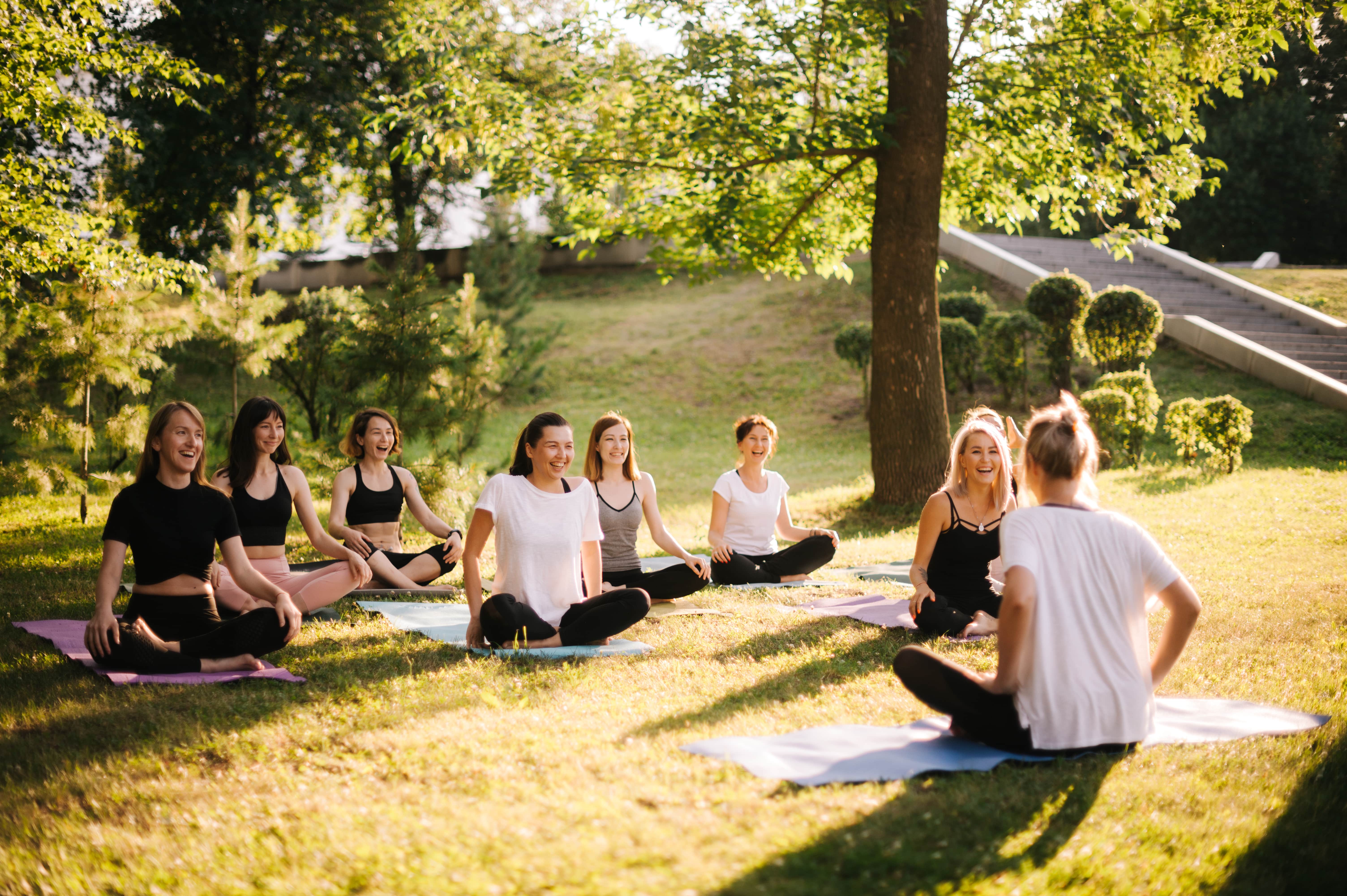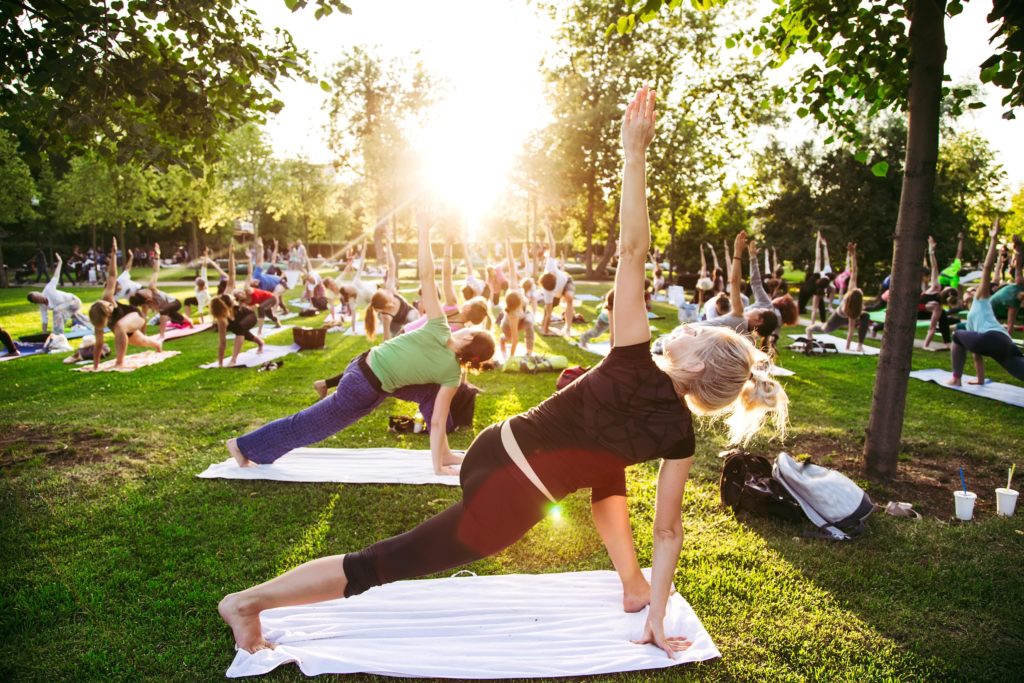
Outdoor classes are gaining popularity in recent years, especially after the outbreak of the Corona pandemic. Various fitness classes and yoga sessions are offered outdoors in nice weather to restore a sense of community and strengthen the relationship between people and nature.
Outdoor fitness and outdoor yoga come with several advantages and disadvantages. In this starter guide, we introduce their pros and cons and share important tips on managing and marketing outdoor classes.
1. What is an outdoor class?
First and foremost, it is important to answer the question: What is an outdoor class?
An outdoor class can be a fitness workout, a yoga session or even a group run that takes place outdoors, in the fresh air. The type of class and the exact location are of secondary importance. The most important thing about an outdoor class is that it is conducted outside.
There is a wide variety of outdoor classes offered by different trainers. In the field of outdoor fitness, for example, there are outdoor HIIT classes, boot camps, personal training and calisthenics. Fans of outdoor yoga can also choose between various yoga styles and meditation courses.
Whether you want to offer your outdoor class in the park, in the forest or on the beach is up to you. What really counts is building a relationship between you, the participants and nature.

2. Why you should offer outdoor classes?
There are several factors in favor of holding yoga or fitness classes outdoors.
2.1 Exercise and stress relief
Our lives have changed a lot in recent years. Although the home office certainly has many advantages, for many people it means that they don’t necessarily have to leave home. A good workout in the fresh air can relieve stress from the workday and provide the necessary exercise for the day. If the sun is shining, an outdoor class is the perfect opportunity to get some vitamin D.
2.2 It’s economically viable
Outdoor classes are a good idea for both established studios and new trainers. Studios with a lot of regular customers can expand their offer and maybe gain some more customers through the higher visibility. One doesn’t need a lot to start offering outdoor classes. Therefore, they can be a good way for yoga or fitness enthusiasts to start their own business without big investments upfront.
2.3 Physical and mental health
Spending time outdoors with others is also good for the mind. On the one hand, mental health benefits from the positive emotions triggered by the exchange between course participants. On the other hand, the body and immune system are strengthened by exercising in the fresh air. In addition, the risk of contracting Corona and other viruses is much lower outdoors than in the gym.
Here is a brief summary of the benefits of yoga and outdoor fitness:
- – Time in nature reduces stress.
- – Exercise in the fresh air and vitamin D strengthen the immune system.
- – Established studios can expand their offering through outdoor classes.
- – New trainers are able to offer outdoor fitness or yoga classes without large investments.
- – The risk of infection is very low outdoors.
- – Outdoor classes in unusual places can be an effective marketing activity.

3. What is important to keep in mind for outdoor classes
It’s clear that you need to be certified as a fitness trainer or yoga teacher to organize outdoor classes. However, you might also need a permit from the city if they want to do it in a public park. Even if you run your classes in your garden or on your roof terrace, you should make sure you are legally covered to avoid any unpleasant surprises.
4. How to find a suitable location for your outdoor classes
Choosing a location for your outdoor classes depends a lot on what kind of classes you want to offer and what your clients’ preferences are.
4.1 Location for outdoor fitness
For example, public parks are very suitable for outdoor fitness classes. Available equipment, playgrounds and even benches can be used in your training if you creatively integrate them into the exercises. This way, you don’t have to bring as much equipment with you. Another option is to use private gardens or backyards.
4.2 Location for outdoor yoga
When it comes to outdoor yoga, a peaceful atmosphere is much more important than the availability of on-site equipment. Outdoor yoga classes can be organized in quiet places in parks, on the beach or even in the forest. Private grounds such as a garden or roof terrace are another good option if they are away from noise sources such as road traffic.
IMPORTANT: Always remember to inform your participants well in advance if they need to bring their own equipment. In the course description, you should always state if you will provide the equipment needed or if you expect your clients to do so.

5. How to deal with bad weather
Studio owners rarely worry about the weather. But this is not the case for people who offer fitness classes or yoga sessions outdoors. Walking a few kilometers in the rain can be fun, but it’s difficult to meditate in the park during a storm.
If you want to run outdoor classes, you should think carefully about what you do in bad weather. Is your target group motivated enough to show up in lower temperatures? Do you have enough water and space in the shade for the participants if it gets really hot outside? What happens if it starts to rain?
Our tip on weather is to choose a suitable location that allows you to react quickly, and write a guide that clearly describes if and how your outdoor classes will take place in different weather conditions.

6. What do your customers think of the idea of outdoor classes?
Many people like the concept of outdoor sports and enjoy taking part in outdoor fitness and yoga classes. However, there are also those who prefer the pleasant atmosphere of a yoga studio or the variety of fitness equipment in a gym.
Before you start outdoor classes, it is important to get in touch with your clients and discuss your idea. Maybe they all want to try something new, maybe you find that they prefer your regular classes. A little quiz on Instagram can give you a good indication if you are on the right track and how you can improve your concept.
7. How do you set the prices for your outdoor classes?
To set the prices for your outdoor classes, you can take a look at the existing outdoor fitness and yoga offerings in the area. In the beginning, you can temporarily set your prices relatively low to attract customers. In the long run, however, you should raise your prices and focus on the quality of your classes, because someone can always come up with a more affordable offer. However, the relationships you build with your clients are more difficult to replace.
8. How to do marketing for outdoor classes
The marketing for outdoor fitness or yoga classes doesn’t differ a lot from the usual marketing of a sports offer. Of course, well-maintained social media profiles are a must. An informative website usually doesn’t hurt either, and can in fact be very valuable if you give potential customers the opportunity to book and pay for your outdoor classes online.
A big advantage of outdoor classes is that you can enjoy a lot of visibility in public spaces. For example, if your HIIT training or yoga classes take place in the park, they are visible to everyone passing by. This way you can directly talk to prospects and promote your classes.
Always try to make your logo stand out, even if it’s only on your T-shirt. This way, your brand will gain attention and recognition. Referral programs and free trials are other good marketing activities that are relatively easy to implement.

9. Managing outdoor classes with FitogramPro
The management of outdoor classes is way easier with a suitable software. More than 2,500 studios already use FitogramPro to manage their classes, whether outdoor, online or in-studio.
Within a few minutes you can create your course plan in FitogramPro, select your desired payment methods and add your location. This way you enable your customers to discover, book and pay for your classes online. The software gives you an overview of the payments and allows you to adjust your offer at any time.
Thanks to the mobile version of FitogramPro, you can check in participants from your mobile phone regardless of the location and add additional information to the course description.
And the best part? FitogramPro has a free version with all the basic features you need to manage your outdoor classes. Sign up now and discover how easy it is to offer and manage outdoor fitness and yoga.
Summary
Outdoor classes are a great way to diversify your fitness or yoga offering. Even if you are just starting out as a fitness trainer or yoga teacher, they allow you to get your first clients and test your concept on a small budget.
We hope that the information in this starter guide will help you to become successful with outdoor fitness or yoga classes!
More from Fitogram:

Your starter guide for outdoor fitness and yoga classes
In this starter guide, we discuss the unique features of outdoor fitness and yoga and share important tips on managing and marketing outdoor classes.

How to start a successful online studio
Digital technologies make starting a business much easier. Most types of trainers, incl. fitness, yoga and others, can start their own online studio in just 30 minutes.

The ultimate guide for a successful online studio
Do you have a passion for yoga, enjoy dancing or want to help others to get fit? Now it’s easier than ever to start your own online studio.

Your starter guide for outdoor fitness and yoga classes
In this starter guide, we discuss the unique features of outdoor fitness and yoga and share important tips on managing and marketing outdoor classes.

How to start a successful online studio
Digital technologies make starting a business much easier. Most types of trainers, incl. fitness, yoga and others, can start their own online studio in just 30 minutes.

The ultimate guide for a successful online studio
Do you have a passion for yoga, enjoy dancing or want to help others to get fit? Now it’s easier than ever to start your own online studio.